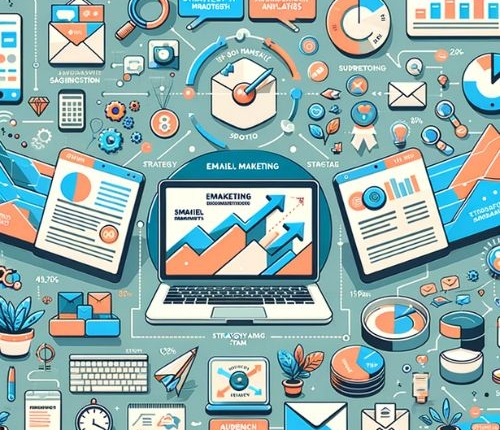How to Be an Email Marketer in the Digital Age: Tools, Trends, and Techniques
Introduction
In the fast-paced world of digital marketing, email remains a cornerstone of communication and engagement. Yet, as we navigate through the digital age, the landscape of email marketing is undergoing significant transformations. Innovations in technology, evolving user expectations, and stringent privacy laws are reshaping how we approach email marketing. This article delves into these changes, highlighting the tools, trends, and techniques essential for success in today’s email marketing domain.
New Primary Key Performance Indicators (KPIs)
The metrics we rely on to gauge the effectiveness of email campaigns are shifting. Traditional indicators like open rates are losing their prominence in the wake of new privacy updates, such as Apple’s Mail Privacy Protection. These changes obstruct the ability to accurately track email opens, rendering open rates a less reliable metric. Consequently, email marketers are turning towards more robust KPIs. Click-through rates, conversion rates, and other engagement metrics are emerging as more indicative measures of an email’s impact. By focusing on these metrics, marketers can obtain a clearer understanding of their campaign’s performance, driving more targeted and effective strategies in the ever-evolving digital landscape.

Microsegmentation in Email Marketing
Microsegmentation elevates the email marketing game by allowing marketers to target ultra-specific audiences. This approach delves deeper than basic demographics, utilizing rich customer data to segment audiences based on behavior, preferences, shopping habits, and even sentiment. The precision of microsegmentation means messages can be tailored to resonate strongly with each niche group, significantly boosting engagement and conversion rates. In essence, microsegmentation transforms broad, generic campaigns into finely tuned, highly relevant communications that speak directly to the individual needs and interests of each segment.
Hyper-Personalization Techniques
In today’s digital marketing landscape, personalization extends far beyond inserting a customer’s name in an email. Hyper-personalization involves crafting emails that forge a deeper connection with the recipient, making them feel uniquely understood and valued. Techniques like sending birthday emails with personalized discount codes, location-based push notifications, or reminders about abandoned shopping carts are examples of hyper-personalization in action. These strategies rely on a deep understanding of individual customer behaviors and preferences, leveraging data to create highly individualized touchpoints that significantly enhance the customer experience and foster stronger brand loyalty.
Leveraging AI and Automation
In the realm of email marketing, AI and automation have emerged as game-changers. These technologies are reshaping how campaigns are executed, making them more efficient and impactful.
Artificial Intelligence in Email Marketing:
AI is being harnessed to refine key aspects of email marketing. One significant area is the optimization of subject lines. Using predictive analytics, AI can determine which subject lines are more likely to capture the audience’s attention, enhancing open rates.
Another area where AI proves invaluable is in the maintenance of mailing lists. It can identify and remove inactive subscribers, ensuring your messages reach an engaged audience. This not only improves campaign metrics but also ensures resources are not wasted on unresponsive contacts.
Automation: A Key to Efficiency:
Automation streamlines routine tasks in email marketing. Transactional emails, such as order confirmations, are sent out automatically, ensuring timely communication without manual intervention.
Beyond routine communications, automation enables personalized interactions at scale. Imagine a scenario where a customer abandons their shopping cart. Automated systems can trigger a personalized email reminder, nudging the customer towards completing the purchase. This level of personalization, made possible by automation, significantly enhances the customer experience and boosts conversion rates.
Incorporating User-Generated Content
User-generated content (UGC) is a powerful tool in the email marketer’s arsenal. It brings authenticity and a human touch to digital communications.
The Power of Authenticity:
UGC, which includes customer reviews, testimonials, and photos, lends credibility to your brand. When recipients see real people endorsing your products or services, it creates a sense of trust and reliability. This is especially important in an age where consumers are bombarded with polished, often impersonal marketing messages.
Building a Community Through UGC:
Incorporating UGC into emails not only enhances content but also fosters a sense of community. It encourages your customers to engage with your brand and share their experiences. This engagement is invaluable, as it turns customers into brand advocates and contributes to a growing, loyal community around your products or services.
In conclusion, leveraging AI and automation in email marketing streamlines processes and enhances personalization, while incorporating UGC adds authenticity and builds trust with your audience. These strategies are essential for creating successful, impactful email campaigns in the digital age.
Interactive Emails for Higher Engagement
Interactive elements in emails, such as polls, mini-games, and call-to-action (CTA) buttons, are changing the landscape of email marketing. These features engage recipients in a way that traditional emails cannot.
Elevating Engagement:
Incorporating interactive elements like polls or quizzes invites recipients to engage directly with the content, making the email experience more dynamic. Mini-games or interactive infographics can significantly boost the time spent on the email, while innovative CTAs encourage higher click-through rates.
Impact on Click-Through Rates:
Interactive emails stand out in crowded inboxes. They capture the recipient’s interest and encourage active participation, leading to higher click-through rates. This engagement is crucial for driving conversions and building a more interactive relationship with the audience.

Email Design: Interesting, Adaptable, and Accessible
A successful email design is not only visually appealing but also adaptable and accessible to all users.
Visual Appeal:
Using illustrations, animations, or dynamic content can make emails more engaging and memorable. Well-crafted visuals can quickly convey your message and capture the reader’s attention.
Adaptability:
Email designs must be adaptable to various devices and screen sizes. With the increasing use of mobile devices, ensuring that your emails look great on both desktop and mobile is essential.
Accessibility:
Finally, accessibility in email design is crucial. Emails should be designed with features like alt text for images and readable fonts, ensuring that they are accessible to all users, including those with disabilities.
Customer Appreciation and Relationship Building
Expressing appreciation to customers is a vital aspect of email marketing. It’s not just about promoting products; it’s about fostering a relationship based on gratitude and recognition.
Celebrating Milestones:
Sending emails that celebrate customer milestones, such as anniversaries or birthdays, adds a personal touch. Combining these emails with special offers or exclusive discounts not only acknowledges the occasion but also encourages continued engagement and loyalty.
Data Privacy and Ethical Considerations
In the digital age, data privacy is paramount in email marketing. Respecting and protecting customer data is not just a legal imperative but also a trust-building measure.
Securing Data:
Implementing robust security protocols to safeguard customer data is crucial. Marketers must ensure that all collected data is stored securely and protected against unauthorized access.
Maintaining Transparency:
Transparency in how customer data is used is essential. Clear communication about data usage, along with providing customers control over their data, such as easy unsubscribe options and preferences settings, builds trust and demonstrates a commitment to ethical practices.
Conclusion
In summary, the landscape of email marketing in the digital age is dynamic and ever-evolving. Key areas like leveraging AI and automation, incorporating user-generated content, utilizing interactive elements, and ensuring designs are interesting, adaptable, and accessible, are transforming how we approach email



